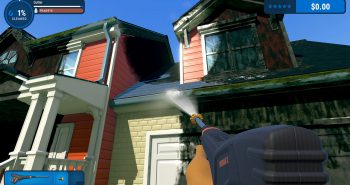When Assassin’s Creed Shadows launches on November 15, it will be the first entry in the franchise built solely for current-generation hardware. Knowing this, the development team at Ubisoft Quebec wanted to do things that had never been done before on Assassin’s Creed, or that frankly couldn’t have been done before. To understand how Assassin’s Creed Shadows uses new tech to bring new experiences to the franchise, we spoke with Art Director Thierry Dansereau and Technology Director Pierre Fortin.
In order to improve image quality and ensure that Shadows is the best-looking Assassin’s Creed ever, the team rescaled the world to more realistic ratios, added ray-tracing global illumination, and utilized micro polygon tech. “We’ve actually had some form of global illumination in Assassin’s Creed for years,” says Fortin. “But ray-tracing global illumination allows us to be much more dynamic.”
In past Assassin’s Creeds, global illumination was static; light would bounce off surfaces and diffuse realistically, but it wouldn’t and couldn’t adapt to environmental changes, and while previous games didn’t allow for many environmental changes, Shadows is filled with them: Lights can be turned off and on, doors can be cut down or smashed through, and bamboo trees, market stalls, and fences can all be destroyed. Thanks to ray-tracing global illumination, the lighting interacting with all of these objects and environments will adjust accordingly.
![[UN] [ACSH] Tech Article - castle](https://staticctf.ubisoft.com/J3yJr34U2pZ2Ieem48Dwy9uqj5PNUQTn/1Rb2RGaFcDeOFtXb1u15JP/a012ee2782ab49f8f0f6e3ac114e4b16/castle.jpg)
Micro polygon tech may not be as familiar of a term as “ray-tracing,” but Fortin highlights just how revolutionary the technology is, even though it’s working behind the scenes. Because Assassin’s Creed’s vast open worlds have long sightlines and draw distances, developers can’t render all visible assets at their full resolution. “Your GPU is going to melt if you do that,” jokes Fortin.
To solve this problem in the past, developers had to build multiple assets with low, medium, and high polygonal counts, and swap them out as the player got closer to them. For example, a building that is visible from two kilometers away doesn’t need to have the same level of detail as a building that’s one meter away, and in the past, the same building would be swapped out with higher-fidelity models as a player moved throughout the world. With micro polygons, developers don’t need to create multiple versions of the same asset to swap out.
“Think of micro polygons as sort of adaptable intelligent assets that know how to render themselves best based on their visibility and proximity to the player,” says Fortin. Not only does this eliminate the need for developers to create multiple assets, but it allows them to budget GPU bandwidth more efficiently, allowing for increased polygon counts and better graphical fidelity up close.
![[UN] [ACSH] Tech Article - world](https://staticctf.ubisoft.com/J3yJr34U2pZ2Ieem48Dwy9uqj5PNUQTn/7hYLiZd8swsAfGbUi68BuW/4a7cefd81b3f07e2eca12464fd072093/World.jpg)
When it came to creating the world, the team aimed for a level of interactivity previously unseen in the franchise. While ray-tracing global illumination and micro polygons help render the environment as the player affects the world, there was an opportunity to have world dynamism that affects the player, too. “Our goal was to make a world that looked good, but also had an impact on gameplay,” says Dansereau.
Assassin’s Creed Shadows features distinct seasons, these make the world visually distinct so that the same location can look and feel vastly different depending on the time of year. But the world can change even within those seasons thanks to dynamic weather, meaning that missions have several environmental factors that can all alter your gameplay experience. With ponds frozen over, for example, there’ll be no taking cover beneath the water. Take on the same mission during a nighttime spring rainstorm, and you’ll find your footsteps muffled by the rain and enemies less likely to spot you in the dark.
“We wanted a dynamic new feeling,” says Fortin. “Both at the micro scale and the macro scale, so that when you see a storm coming, you can adapt how you play the game, knowing that it’s going to make you stealthier when it’s time to sneak into that castle.”
![[UN] [ACSH] Tech Article - forest](https://staticctf.ubisoft.com/J3yJr34U2pZ2Ieem48Dwy9uqj5PNUQTn/5zdNg0QTudI7trTjI6R4T8/123f22af31c9c0cb94b35bc0418d175e/forest.jpg)
With two vastly different protagonists, a setting in feudal Japan, and destructible environments, Assassin’s Creed Shadows is introducing a lot of new features to the franchise, but the technical innovations that change how the world looks and feels might just be the first thing players notice. Fortin hopes that the new level of dynamism adds a sense of immersion and beauty that previous games couldn’t quite capture. “Our goal from the beginning was to go from a beautiful postcard to a beautiful movie.”
Assassin’s Creed Shadows is available for preorder now and launches on November 15 on PS5, Xbox Series X|S, Amazon Luna, Macs with Apple silicon via the Mac App Store, and Windows PC through the Ubisoft Store and the Epic Games Store. The game will also come to iPad at a later date. Players who purchase the Gold Edition, Ultimate Edition, Collector’s Edition, or have a Ubisoft+ Premium subscription can play the game three days early on November 12.





